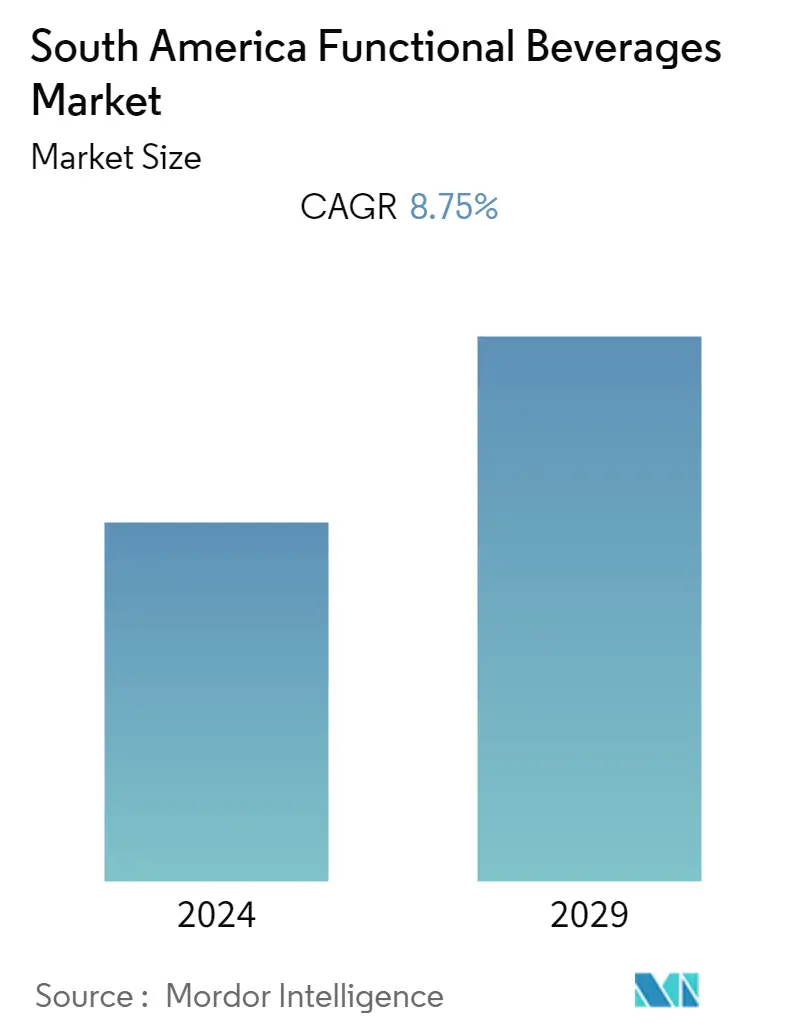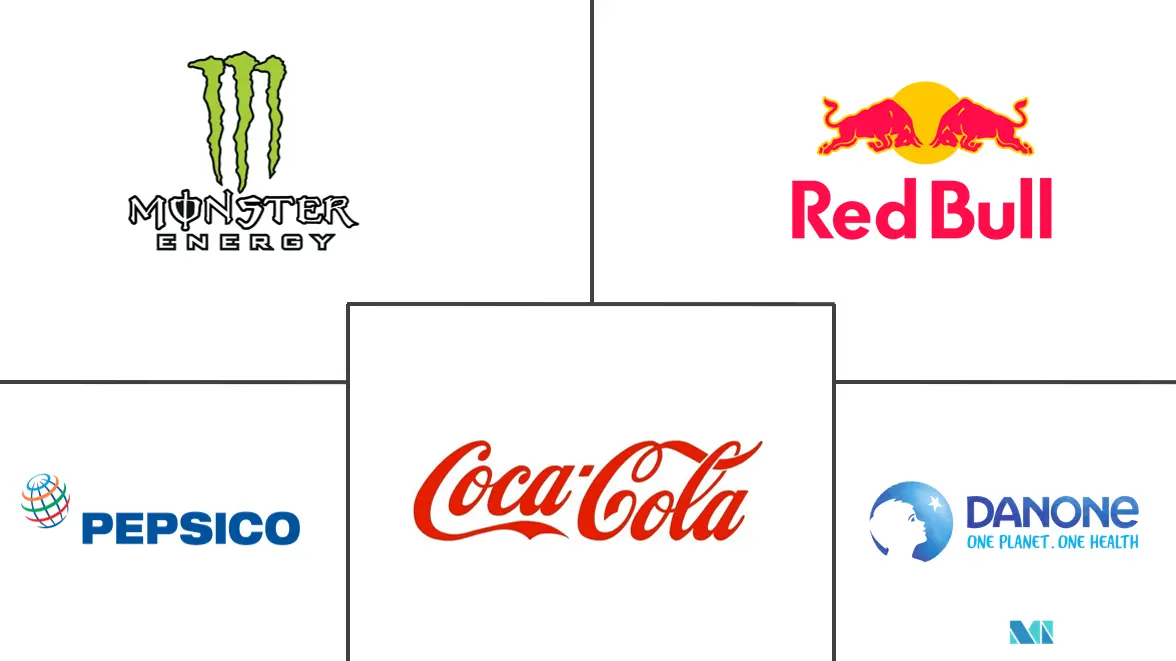Market Size of South America Functional Beverages Industry

| Study Period | 2019 - 2029 |
| Base Year For Estimation | 2023 |
| Forecast Data Period | 2024 - 2029 |
| Historical Data Period | 2019 - 2022 |
| CAGR | 8.75 % |
| Market Concentration | Low |
Major Players
*Disclaimer: Major Players sorted in no particular order |
Functional Beverage in South America Market Analysis
During the time frame of the forecast, the South American functional beverage market is expected to grow at a CAGR of 8.75%.
Health and wellness trends are a big reason why people want drinks that do more than just taste good.As health and disease prevention claims are being made about beverages, consumers are becoming more and more interested in how true those claims are.Changes in consumer needs, such as for immunity and sustainability, as well as a number of market trends, are driving the rise of premium functional beverages and helping the market grow in the region.
Functional drinks that contain protein and claim to give you more energy are becoming more popular, especially among people who like to work out.Immunity is also surging as a key claim in the market. Furthermore, digestive health is likely to be the next functional crowd-pleaser, and brands can leverage this opportunity to create products for which consumers will pay a premium. The increasing number of fitness centers in the region is also contributing to this cause.
As the functional beverage market is highly competitive, manufacturers who want to stand out in the crowd need to stay in tune with changing consumer needs and deliver innovation with the proven scientific benefits of powerful functional ingredients. However, with the increasing health issues associated with the consumption of functional beverages, followed by the prevalence of obesity, the low penetration of functional drinks in other untapped regions might pose hindrances to the overall growth of functional beverages in the region.
Functional Beverage in South America Industry Segmentation
A functional beverage is a non-alcoholic drink that has unusual ingredients like minerals, vitamins, amino acids, dietary fibers (DFs), probiotics, and raw fruits. These ingredients not only provide basic nutrition but also have other health benefits for the human body. Type, distribution method, and geography are the market segments for functional beverages worldwide. Based on type, the market is segmented into energy drinks, sports drinks, fortified juices, dairy and dairy alternative drinks, and functional or fortified water. Based on the distribution channel, the market is segmented into supermarkets, hypermarkets, pharmacies, health stores, convenience stores, online retail stores, and other distribution channels. Based on geography, the market is segmented into Brazil, Argentina, and the rest of South America. For each segment, market sizing and forecasts have been done based on value (in USD million).
| Type | |
| Energy Drinks | |
| Sports Drinks | |
| Fortified Juices | |
| Dairy and Dairy Alternative Drinks | |
| Functional/Fortified Water |
| Distribution Channel | |
| Supermarkets/Hypermarkets | |
| Pharmacies/Health Stores | |
| Convenience Stores | |
| Online Retail Stores | |
| Other Distribution Channels |
| Geography | |
| Brazil | |
| Argentina | |
| Rest of South America |
South America Functional Beverages Market Size Summary
The South American functional beverage market is experiencing significant growth, driven by increasing consumer interest in health and wellness. This trend is fueled by a demand for beverages that offer more than just taste, with a focus on immunity, energy, and digestive health. The rise of premium functional beverages is supported by the growing number of fitness centers and the popularity of protein-rich drinks among fitness enthusiasts. However, the market faces challenges such as health concerns related to functional beverages and low penetration in untapped regions. The competitive landscape requires manufacturers to innovate and align with consumer needs, leveraging scientific benefits to differentiate their products.
In Brazil, the functional beverage market is bolstered by a strong economy and a health-conscious population. The demand for convenient food and beverages is rising due to changing consumption patterns, with chocolate-based drinks and energy drinks gaining popularity. Urbanization and increased disposable income are contributing to the growth of energy drinks, particularly among young consumers. The presence of major soda companies and aggressive marketing strategies, including endorsements and social media promotions, are further driving market expansion. Key players like PepsiCo, Coca-Cola, and Red Bull are actively competing, with product innovations and strategic launches enhancing their market presence.
South America Functional Beverages Market Size - Table of Contents
-
1. MARKET DYNAMICS
-
1.1 Market Drivers
-
1.2 Market Restraints
-
1.3 Porter's Five Forces Analysis
-
1.3.1 Threat of New Entrants
-
1.3.2 Bargaining Power of Buyers/Consumers
-
1.3.3 Bargaining Power of Suppliers
-
1.3.4 Threat of Substitute Products
-
1.3.5 Intensity of Competitive Rivalry
-
-
-
2. MARKET SEGMENTATION
-
2.1 Type
-
2.1.1 Energy Drinks
-
2.1.2 Sports Drinks
-
2.1.3 Fortified Juices
-
2.1.4 Dairy and Dairy Alternative Drinks
-
2.1.5 Functional/Fortified Water
-
-
2.2 Distribution Channel
-
2.2.1 Supermarkets/Hypermarkets
-
2.2.2 Pharmacies/Health Stores
-
2.2.3 Convenience Stores
-
2.2.4 Online Retail Stores
-
2.2.5 Other Distribution Channels
-
-
2.3 Geography
-
2.3.1 Brazil
-
2.3.2 Argentina
-
2.3.3 Rest of South America
-
-
South America Functional Beverages Market Size FAQs
What is the current South America Functional Beverages Market size?
The South America Functional Beverages Market is projected to register a CAGR of 8.75% during the forecast period (2024-2029)
Who are the key players in South America Functional Beverages Market?
PepsiCo, Inc., The Coca-Cola Company, Red Bull GmbH, Monster Beverage Corporation and Danone SA are the major companies operating in the South America Functional Beverages Market.

